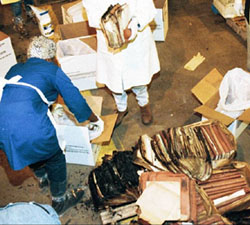
Wet Records
Many record materials will respond well to simple air drying as long as minor physical distortion is acceptable. Small quantities may be spread out on top of clean blotting material (paper toweling, etc.) in a cool dry location with plenty of air circulation.
As long as materials are not too densely packed and active drying conditions are maintained, mold growth should be mitigated. While high heat and harsh sunlight will dry records quickly, they may permanently damage record materials and should be avoided.
Quantities too large to handle within the first 48 hours should be frozen either for defrosting and air drying at a later date, or for referral to a commercial drying vendor or preservation professional.
For response and recovery guidelines see:
- A Primer on Disaster Preparedness, Management and Response: Paper-Based Materials
- Salvage Operations for Water Damaged Collections by Betty Walsh, Conservator Provincial Archives of British Columbia
Some record materials will dry more satisfactorily than others; and metal, plate glass, some photographs and furniture may be exceptions to freezing. Questions about the treatment of particularly valuable wet records should be referred to a preservation professional immediately.
For a referral, see:
 When records are very wet, teams line clean, dry boxes with thin plastic bags before filling to keep the boxes dry.
When records are very wet, teams line clean, dry boxes with thin plastic bags before filling to keep the boxes dry.